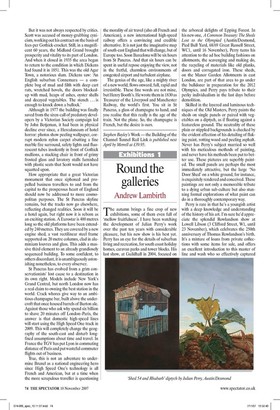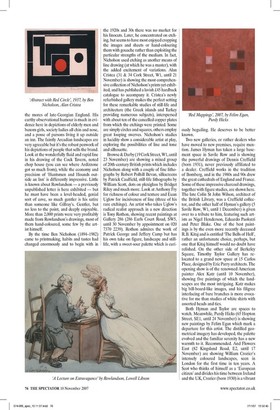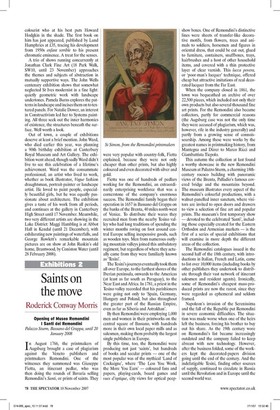Round the galleries Andrew Lambirth
The autumn brings a fine crop of new exhibitions, some of them even full of 'mellow fruitfulness'. I have been watching the development of Julian Perry's work over the past ten years with considerable pleasure, but his new show is his best yet. Perry has an eye for the details of suburban living and recreation, for south coast holiday homes, caravan parks and tower blocks. His last show, at Guildhall in 2004, focused on the arboreal delights of Epping Forest. In his new one, A Common Treasury: The Sheds Lost to the Olympiad (Austin/Desmond, Pied Bull Yard, 68/69 Great Russell Street, WC1, until 16 November), Perry turns his attention to the ad hoc building fashions on allotments, the scavenging and making do, the recycling of materials like old planks, doors and corrugated iron. These sheds, on the Manor Garden Allotments in east London, are part of that area to go under the bulldozer in preparation for the 2012 Olympics, and Perry pays tribute to their perky individualism in the last days before demolition.
Skilled in the layered and luminous techniques of the Old Masters, Perry paints the sheds on single panels or paired with vegetables on a diptych, as if floating against a featureless ground. The neutrality of these plain or stippled backgrounds is checked by the evident affection of his detailing of flaking paint, rotting wood and peeling asphalt. Never has Perry's subject married so well with his meticulous methods of painting, and never have his methods been put to better use. These pictures are superbly painted. The small panels are perhaps the most immediately attractive, but the large 'No Door Shed' on a white ground, for instance, is exquisitely rendered and conceived. These paintings are not only a memorable tribute to a dying urban sub-culture but also stunning formal explorations of what paint can do in a thoroughly contemporary way.
Perry is rare in that he's a youngish artist with a deep knowledge and understanding of the history of his art. I'm sure he'd appreciate the splendid Rowlandson show at Lowell Libson (3 Clifford Street, W1, until 23 November), which celebrates the 250th anniversary of Thomas Rowlandson's birth. It's a mixture of loans from private collections with some items for sale, and offers an excellent introduction to this master of line and wash who so effectively captured the mores of late-Georgian England. His earthy observational humour is much in evidence here in depictions of elderly men and buxom girls, society ladies all chin and nose, and a posse of parsons living it up outside an inn. The faintly Arcadian landscapes are very agreeable but it's the robust penwork of his depictions of people that sells the brand. Look at the wonderfully fluid and rapid line in his drawing of the Cock Tavern, noted chop house (you can see where Ardizzone got so much from), while the economy and precision of 'Huntsmen and Hounds outside an Inn' is differently impressive. Little is known about Rowlandson — a previously unpublished letter is here exhibited — but he must have been a level-headed, genial sort of cove, so much gentler is his satire than someone like Gillray's. Gentler, but no less to the point, and deeply enjoyable. More than 2,000 prints were very profitably made from Rowlandson's drawings, most of them hand-coloured, some few by the artist himself.
By the time Ben Nicholson (1894-1982) came to printmaking, habits and tastes had changed enormously and to begin with in the 1920s and 30s there was no market for his linocuts. Later, he concentrated on etching, but seems to have most enjoyed cropping the images and sheets or hand-colouring them with gouache rather than exploiting the particular strengths of the medium. In fact, Nicholson used etching as another means of line drawing (at which he was a master), with the added excitement of variations. Alan Cristea (31 & 34 Cork Street, W1, until 21 November) is showing the most comprehensive collection of Nicholson's prints yet exhibited, and has published a lavish £45 hardback catalogue to accompany it. Cristea's newly refurbished gallery makes the perfect setting for these remarkable studies of still-life and architecture (the Greek islands and Turkey providing numerous subjects), interspersed with about ten of the cancelled copper plates from which the etchings were printed. Some are simply circles and squares, others employ great looping swerves. Nicholson's studies in lucidity show a considerable artist at play, exploring the possibilities of line and tone and silhouette.
Browse & Darby (19 Cork Street, W1, until 23 November) are showing a mixed group of 20th-century British prints which includes Nicholson along with a couple of fine lithographs by Robert Polhill Bevan, silkscreens by Patrick Caulfield, still-life lithographs by William Scott, dots on plexiglass by Bridget Riley and much more. Look at Anthony Fry for richness of colour and texture and Euan Uglow for incisiveness of line (three of his rare etchings). An artist who takes Uglow's radical realist approach in a new direction is Tony Rothon, showing recent paintings at Gallery 286 (286 Earls Court Road, 5W5, until 30 November by appointment on 020 7370 2239). Rothon admires the work of Patrick George and Jeffery Camp but has his own take on figure, landscape and stilllife, with a sweet-sour palette which is curiously beguiling. He deserves to be better known.
Two new galleries, or rather dealers who have moved to new premises, require mention. James Hyman has taken a large basement space in Savile Row and is showing the powerful drawings of Dennis Creffield (born 1931), never previously affiliated to a dealer. Creffield works in the tradition of Bomberg, and in the 1980s and 90s drew the great cathedrals of England and France. Some of these impressive charcoal drawings, together with figure studies, are shown here. The late Cohn St John Wilson, architect of the British Library, was a Creffield collector, and the other half of Hyman's gallery (5 Savile Row, W1, until 1 December) is given over to a tribute to him, featuring such artists as Nigel Henderson, Eduardo Paolozzi and Peter Blake. One of the best paintings is by the even more recently deceased R.B. Kitaj and is entitled 'The Bells of Hell', rather an unfortunate choice, perhaps, but one that Kitaj himself would no doubt have relished. On the other side of Berkeley Square, Timothy Taylor Gallery has relocated to a grand new space at 15 Carlos Place, designed by Eric Parry architects. The opening show is of the renowned American painter Alex Katz (until 10 November), showing five paintings of which the landscapes are the most intriguing. Katz makes big bill-board-like images, and his filigree interlacing of bare branches is more evocative for me than studies of white shirts with assorted heads and ties.
Both Hyman and Taylor are spaces to watch. Meanwhile, Purdy Hicks (65 Hopton Street, SE1, until 24 November) is showing new paintings by Felim Egan which mark a departure for this artist. The distilled geometrical imagery has developed, the palette evolved and the familiar serenity has a new warmth to it. Recommended. And Flowers East (82 Kingsland Road, E2, until 17 November) are showing William Crozier's intensely coloured landscapes, seen in London for the first time in ten years. A Scot who thinks of himself as a 'European citizen' and divides his time between Ireland and the UK, Crozier (born 1930) is a vibrant colourist who at his best puts Howard Hodgkin in the shade. The first book on him has just appeared, published by Lund Humphries at £35, tracing his development from 1950s enfant terrible to his present chromatic eminence. A treat for the senses.
A trio of shows running concurrently at Jonathan Clark Fine Art (18 Park Walk, SW10, until 23 November) approaches the themes and subjects of abstraction in mutually supportive ways. The John Wells centenary exhibition shows that somewhat neglected St Ives modernist in a fine light: quietly geometric work with landscape undertones. Pamela Burns explores the patterns in landscape and incises them on to textured panels. For Natalie Dower, an interest in Constructivism led her to Systems painting. All three seek out the inner harmonies of existence, the structures beneath the surface. Well worth a look.
Out of town, a couple of exhibitions deserve at least a brief mention. John Ward, who died earlier this year, was planning a 90th birthday exhibition at Canterbury Royal Museum and Art Gallery. The exhibition went ahead, though sadly Ward didn't live to see this celebration of a lifetime's achievement. Ward was the consummate professional, an artist who lived to work, whether as book illustrator, Vogue fashion draughtsman, portrait-painter or landscape artist. He loved to paint people, especially beautiful girls, but he was equally passionate about architecture. The exhibition gives a taste of his work from all periods, and continues at the gallery in Canterbury High Street until 17 November. Meanwhile, two very different artists are showing in the Lake District: Maggi Hambling is at Abbot Hall in Kendal (until 21 December), with exhilarating new paintings of waterfalls, and George Rowlett's remarkable mountain pictures are on show at John Ruskin's old home, Brantwood, by Coniston Water (until 28 February 2008).







































































 Previous page
Previous page